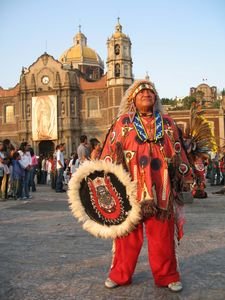Advertisement
Published: January 5th 2008

 Basilica I
Basilica I
A performer at the Basilica of the Virgen de Guadalupe, Mexico City.
(I have to thank a fellow observer who shared his photo opportunity with me).Before the Mother of God began making appearances in grottos and pastures around Europe, she turned up on a hill-top near Mexico City. It was December 1531, the Spanish conquest of the Aztec empire had begun 12 years before, and Catholicism was being peddled to the indigenous population.
The apparition of the Virgin to a recently converted local man named Juan Diego led to the subsequent evangelization of millions, the construction of a basilica on the hill-top, and the designating of December 12th as the feast day of the Virgin,
Nuestra Señora de Guadalupe.
The pilgrimage to the site of the vision - now home to two basilicas since the original one began to sink into the ground it was constructed on - is often made on foot, by bicycle, or even in part on one’s knees. I made it by public transport, hunched up over the wheel of a bus, suffocated by the huge sleeping man wedged beside me and the duelling scents of sweat and tortilla.
Mapless, I was relying on road signs glimpsed from the greasy window to signal my proximity to the holy site. On December the 12th one doesn’t have to worry about

 Basilica VI
Basilica VI
A lucha libre type at the basilica of the Virgen de Guadalupe, Mexico City. missing the stop. A river of bodies was coursing through the street and spilling out around the gates of the basilica. Every so often a Virgin, in statuette or portrait form, bobbed above the multitude of heads and advanced, seesawing, towards the sanctuary.
The befeathered dancers, musical troupes and tight-rope walkers bore little relation to my previous experience of a Marian shrine, when, as a sullen schoolgirl, I had been obliged to traipse around the site at Knock under leaden skies, muttering half-learned prayers in feigned piety.
But
La Morenita, as she is also known, is more than just a version of the Catholic Madonna. Featured on the flags of Mexican revolutionaries, she is a symbol of national identity, and there are those who argue that she is a syncretic figure, a mixture of the Virgin Mary and the indigenous Mexican goddess Tonantzin, who provided an ease of transition from the spiritual beliefs of the indigenous people to the Catholicism of the
conquistadores, or an acceptable veneer for the continued covert worship of a pagan goddess. Her importance to Mexican national identity and the semi-pagan aspect of her veneration that is often suggested were summed up by novelist Carlos

 Basilica V
Basilica V
Performers at the basilica of the Virgen de Guadalupe, Mexico City.Fuentes: "One may no longer consider himself a Christian, but you cannot truly be considered a Mexican unless you believe in the Virgin of Guadalupe".
Beyond the assault of colour and costume there was a seriousness, the kind of concentration that comes with spiritual devotion. The dancers and musicians moved in formation, but were oblivious to one another, each in their own individual reverie, a trance-like vacancy in their eyes.
Inside the sinking basilica worshippers kneeled in prayer before a large framed image of the Virgin, tied ribbons to and deposited flowers at the feet of garish statues, and pinned photographs of loved ones to the mantle of a ceramic idol. In the modern building pilgrims unburdened themselves of the framed images or miniature Virgins they had carried, strapped to their backs, since initiating their peregrinations and sagged against the walls, exhausted by emotion and journeying. Those anxious for a memento of their pilgrimage had only to step outside into the labyrinth of stalls selling all variety of kitsch objects emblazoned with
La Morenita’s image, or pay their few pesos for a photo opportunity with a plastic Virgin or Juan Diego or even a cardboard cut-out of Pope John

 Virgin on parade
Virgin on parade
On the way to the basilica.Paul II.
I left the site as the sun was setting, struggling against the tide of Virgins still teetering towards their spiritual home on upraised arms and weary shoulders.
Advertisement
Tot: 0.21s; Tpl: 0.012s; cc: 24; qc: 112; dbt: 0.1313s; 1; m:domysql w:travelblog (10.17.0.13); sld: 1;
; mem: 1.3mb

 Basilica I
Basilica I
 Basilica VI
Basilica VI
 Basilica V
Basilica V
 Virgin on parade
Virgin on parade



















Gia82
Gia Thompson
WONDERFUL!! So COLORFUL!
Great pics and I loved the way you wrote about your expeirence. Very intresting and neat! Kuddos to you!!